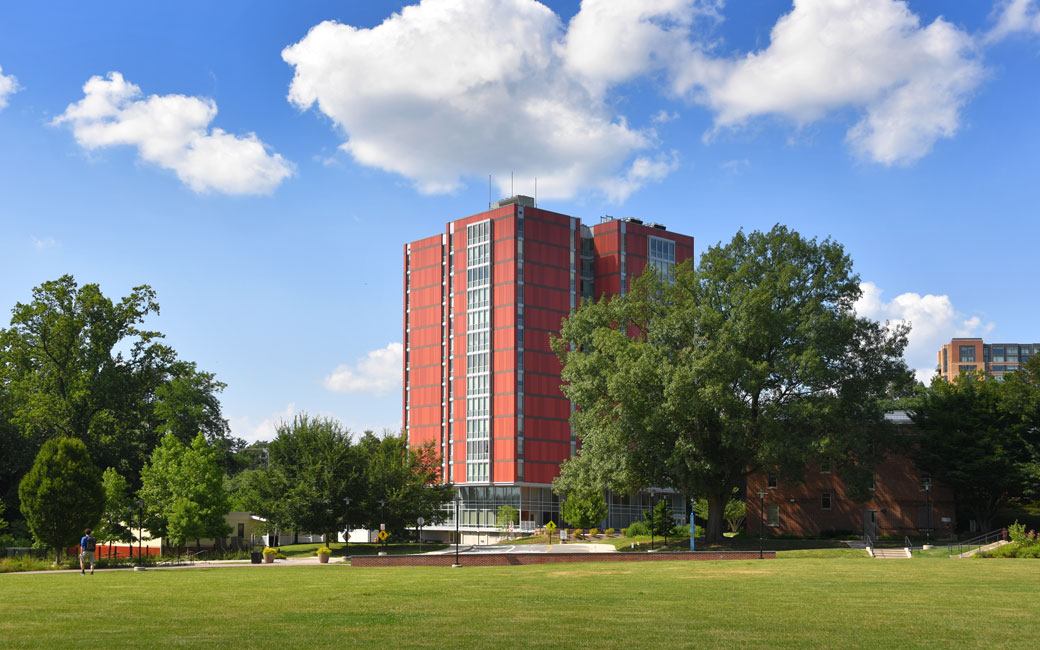TU’s Residence Tower earns LEED Gold Certification
Award honors the university’s commitment to implementing measurable green building design, construction, operations and maintenance
By Kyle Hobstetter on September 4, 2019
After going through a two-year renovation, Towson University’s Residence Tower, which was reopened for the fall 2018 academic term, was awarded a U.S. Green Building Council’s Leadership in Energy and Environmental Design (LEED) Gold Certification.
As a benchmark for the sustainability of campus buildings, LEED provides a framework for identifying and implementing measurable green building design, construction, operations and maintenance solutions.
With all capital projects, the state of Maryland requires all buildings to have a goal of earning a LEED Silver certification. Buildings can receive four different certifications: bronze, silver, gold or platinum.
But since 2007, Towson University has been committed to building all new construction projects to the LEED Gold certification standards.
The $32.5 million renovation saw the complete reconstruction of the 100,000-square foot building from the inside out.
The Residence Tower was built in 1972. And while conventional thinking would have led to it being demolished in coming years to make space for a new residence hall, Towson University Facilities Management staff knew that a complete renovation could not only save money, but provide a new green and sustainable building on campus.
“We have a commitment to sustainable practices and improving the environment,” says Towson University architect David Mayhew. “With the Residence Tower, and it being the first renovation in over 40 years, we can make renovations that save energy and save a lot of money in the long run.”

To receive a LEED Certification, a building is judged on six different categories:
- Sustainable Site Development
- Water Efficiency
- Energy and Atmosphere
- Materials and Resources
- Indoor Environmental Quality
- Innovation
During the renovation, Facilities Management worked to provide several changes to the building. This included the use of low flow and efficient bathroom fixtures, introducing an efficient air conditioning and heating system, using recycled materials in the construction, and controllable indoor comfort and lighting system.
Facilities Management has also implemented a Green Cleaning Policy, which promises not to use harmful cleaning supplies and chemicals during maintenance of the building.
With the Residence Tower, campus now has 10 buildings that have received LEED Certifications, including five that have earned Gold, including Residence Tower, the West Village Commons Building, SECU Arena, Marshall Hall and Carroll Hall.
For Mayhew and the rest of facilities management, these certifications confirm they are providing healthy spaces for students, faculty and staff.
“These projects are designed with the campus in mind,” he says. “It’s gratifying to see this 40-year-old building become a new, efficient and modern building, that’s relevant to the way students want to live.”
That’s another reason the Residence Tower wasn’t torn down: the building's bones were healthy enough and provide the type of rooms and layout that are perfect for a college community.
At 14-floors tall, the building provides 400 beds and takes up just a small footprint of the campus. It also fosters student interaction because each floor has four quads with six to eight people in each quad — up to 32 people on each floor.
Facilities Management transformed the first two floors into community space, with a large kitchen, game room and common areas in a loft-like setting overlooking the building’s main entrance.
The exterior of the building also got a facelift — replacing the old concrete facade with large architectural panels in various brick tones consistent with the College of Liberal Arts building and the overall campus aesthetic.
“It went from this heavy concrete bunker to this transparent, well-lit and welcoming building,” Mayhew says. “It’s just a better connection to the campus.”
Stay up to date on all of Towson University’s current and completed construction. Also, learn more about Towson University’s sustainability efforts.
This story is one of several related to President Kim Schatzel’s priorities for Towson University: TU Matters to Maryland, Strategic Plan Alignment.